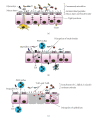Interactions of the intestinal epithelium with the pathogen and the indigenous microbiota: a three-way crosstalk
- PMID: 19259328
- PMCID: PMC2648619
- DOI: 10.1155/2008/626827
Interactions of the intestinal epithelium with the pathogen and the indigenous microbiota: a three-way crosstalk
Abstract
The mucosal surfaces of the gastrointestinal tract harbor a vast number of commensal microbiota that have coevolved with the host, and in addition display one of the most complex relationships with the host. This relationship affects several important aspects of the biology of the host including the synthesis of nutrients, protection against infection, and the development of the immune system. On the other hand, despite the existence of several lines of mucosal defense mechanisms, pathogenic organisms such as Shigella and Salmonella have evolved sophisticated virulence strategies for breaching these barriers. The constant challenge from these pathogens and the attempts by the host to counter them set up a dynamic equilibrium of cellular and molecular crosstalk. Even slight perturbations in this equilibrium may be detrimental to the host leading to severe bacterial infection or even autoimmune diseases like inflammatory bowel disease. Several experimental model systems, including germ-free mice and antibiotic-treated mice, have been used by various researchers to study this complex relationship. Although it is only the beginning, it promises to be an exciting era in the study of these host-microbe relationships.
Figures

Similar articles
-
Commensal bacteria (normal microflora), mucosal immunity and chronic inflammatory and autoimmune diseases.Immunol Lett. 2004 May 15;93(2-3):97-108. doi: 10.1016/j.imlet.2004.02.005. Immunol Lett. 2004. PMID: 15158604 Review.
-
The Roles of Inflammation, Nutrient Availability and the Commensal Microbiota in Enteric Pathogen Infection.Microbiol Spectr. 2015 Jun;3(3). doi: 10.1128/microbiolspec.MBP-0008-2014. Microbiol Spectr. 2015. PMID: 26185088
-
Regulation of virulence: the rise and fall of gastrointestinal pathogens.J Gastroenterol. 2016 Mar;51(3):195-205. doi: 10.1007/s00535-015-1141-5. Epub 2015 Nov 10. J Gastroenterol. 2016. PMID: 26553054 Free PMC article. Review.
-
Development, validation and implementation of an in vitro model for the study of metabolic and immune function in normal and inflamed human colonic epithelium.Dan Med J. 2015 Jan;62(1):B4973. Dan Med J. 2015. PMID: 25557335 Review.
-
The streptomycin mouse model for Salmonella diarrhea: functional analysis of the microbiota, the pathogen's virulence factors, and the host's mucosal immune response.Immunol Rev. 2012 Jan;245(1):56-83. doi: 10.1111/j.1600-065X.2011.01070.x. Immunol Rev. 2012. PMID: 22168414 Review.
Cited by
-
The Importance of Intestinal Microbiota and Dysbiosis in the Context of the Development of Intestinal Lymphoma in Dogs and Cats.Cancers (Basel). 2024 Jun 18;16(12):2255. doi: 10.3390/cancers16122255. Cancers (Basel). 2024. PMID: 38927960 Free PMC article. Review.
-
Role of toll like receptors in irritable bowel syndrome: differential mucosal immune activation according to the disease subtype.PLoS One. 2012;7(8):e42777. doi: 10.1371/journal.pone.0042777. Epub 2012 Aug 17. PLoS One. 2012. PMID: 23028414 Free PMC article.
-
Association of lung-intestinal microecology and lung cancer therapy.Chin Med. 2023 Apr 10;18(1):37. doi: 10.1186/s13020-023-00742-8. Chin Med. 2023. PMID: 37038223 Free PMC article. Review.
-
Neonatal immune adaptation of the gut and its role during infections.Clin Dev Immunol. 2013;2013:270301. doi: 10.1155/2013/270301. Epub 2013 May 2. Clin Dev Immunol. 2013. PMID: 23737810 Free PMC article. Review.
-
Gnotobiotic mouse model's contribution to understanding host-pathogen interactions.Cell Mol Life Sci. 2016 Oct;73(20):3961-9. doi: 10.1007/s00018-016-2341-8. Epub 2016 Aug 20. Cell Mol Life Sci. 2016. PMID: 27544211 Free PMC article. Review.
References
-
- Savage DC. Microbial ecology of the gastrointestinal tract. Annual Review of Microbiology. 1977;31:107–133. - PubMed
-
- Hooper LV, Midwedt T, Gordon JI. How host-microbial interactions shape the nutrient environment of the mammalian intestine. Annual Review of Nutrition. 2002;22:283–307. - PubMed
-
- Kelsall BL. Innate and adaptive mechanisms to control of pathological intestinal inflammation. The Journal of Pathology. 2008;214(2):242–259. - PubMed
-
- Ley RE, Turnbaugh PJ, Klein S, Gordon JI. Microbial ecology: human gut microbes associated with obesity. Nature. 2006;444(7122):1022–1023. - PubMed
-
- Turnbaugh PJ, Ley RE, Mahowald MA, Magrini V, Mardis ER, Gordon JI. An obesity-associated gut microbiome with increased capacity for energy harvest. Nature. 2006;444(7122):1027–1031. - PubMed
Grants and funding
LinkOut - more resources
Full Text Sources

